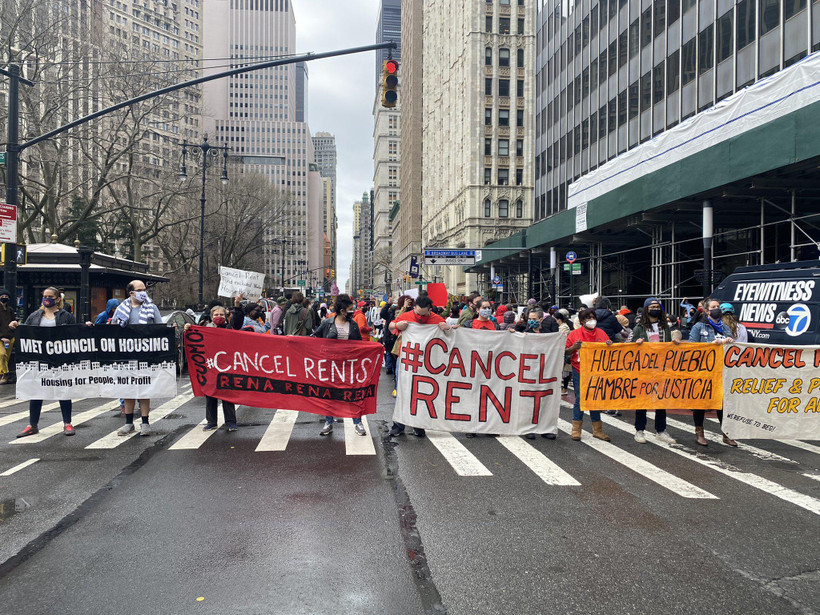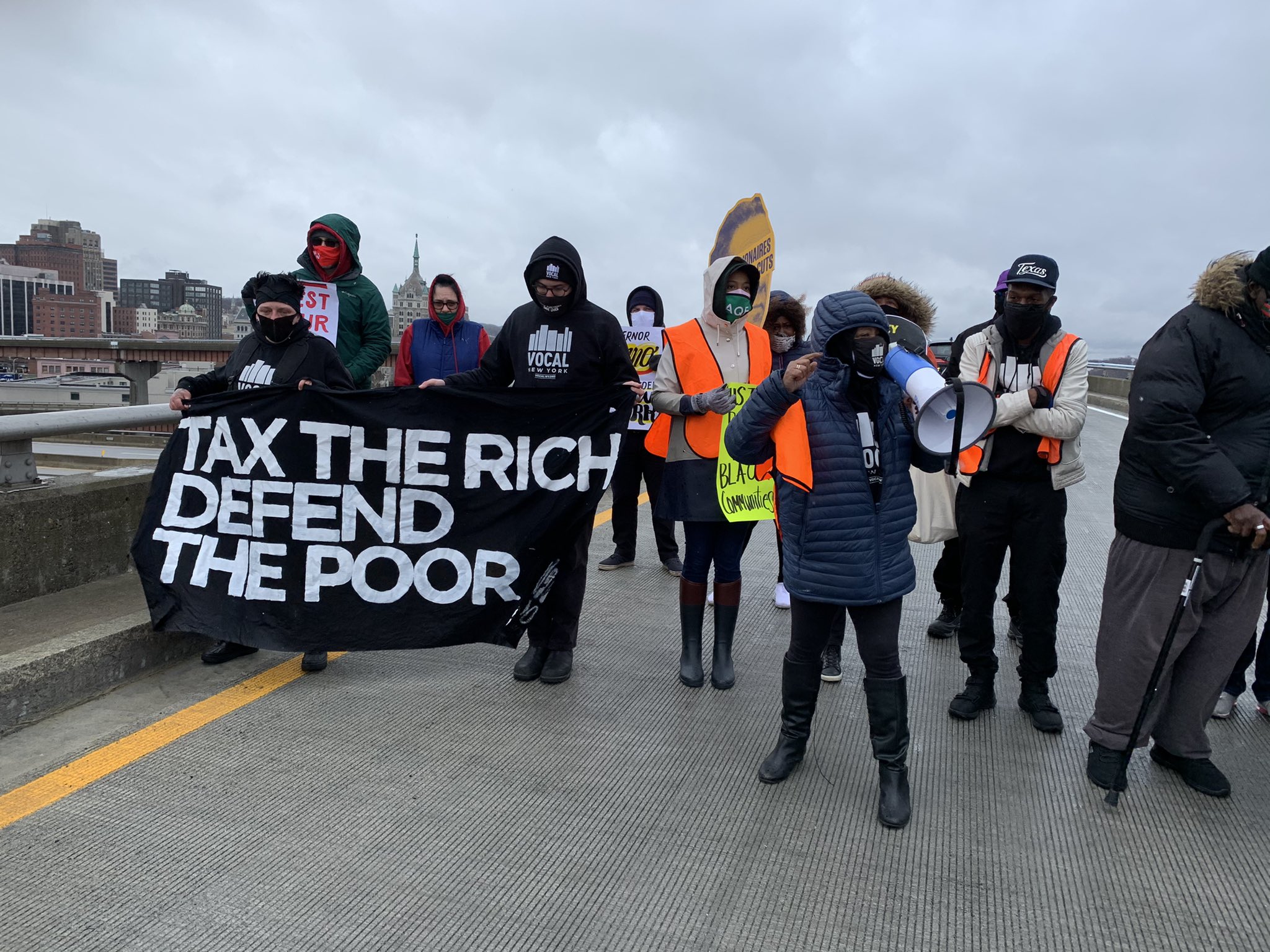Will New York’s Rent Relief Program Address The Problems that Hobbled The Last One?
Governor Andrew Cuomo is pushing to impose stringent requirements, according to lawmakers and tenant advocates, that could delay and decrease aid.

In December and March, the federal government allotted $2.3 billion in rent relief to the up to 1.2 million New Yorkers who are behind on their rent.
How to distribute these funds is largely up to New York’s state government. Lawmakers and tenant advocates say that in ongoing budget negotiations, Governor Andrew Cuomo is pushing to impose stringent requirements on tenants that could significantly delay and restrict the distribution of relief.
The state’s last rent relief program rejected the vast majority of applicants and distributed only $47 million of its $100 million budget. “That program was designed to fail,” said Ellen Davidson, a tenant attorney at the Legal Aid Society, citing a byzantine application process and proof-of-eligibility requirements.
Davidson said that the legislature has taken steps in its budget proposals to avoid similar pitfalls. “The Senate and Assembly learned their lesson, because you can see some of the mistakes not repeated in their proposals. I’m hoping that the executive will take a moment to think about why that program failed and be part of designing a program that succeeds,” she said.
But lawmakers say that the governor is again proposing extensive means-testing of tenants applying for relief, similar to some of the conditions that hamstrung the previous rent relief program, as well as reduced protections against evictions and rent hikes.
“They are obsessed with the narrative of deserving poor people. That’s going to backfire, because it’s going to take too long. And because the more you ask of people, in an attempt to reach the poorest people— the poorest people are going to be the ones least likely to have it,” said Cea Weaver, coordinator of the Housing Justice for All Coalition.
“You send them your whole life”
Matisse Lee, a 40 year old woman living in Jamaica Estates, owes over $20,000 in back rent. She lost her job working in a medical team at the Rikers Island Jail complex in August, she said, after she had to reduce her hours to take care of a friend experiencing mental health issues who had attempted suicide in her apartment.
Lee has twice applied and twice been denied for New York’s previous rounds of rent relief, she said, first because of a short period last year in which she earned too much income, and then because she’d received too much in unemployment assistance.
“Send this document, send that document, show proof that your son has mental health issues, and that you’re not working, and when did you stop working,” she described the application process. “You send them your whole life. Your whole life. And then they deny you."
“We don’t have health insurance. I have a disability and so does my son, and we’re in and out of the hospital. I have to choose between paying my rent with my unemployment or paying medical bills. I don’t sleep. I don’t eat. I’m breaking out in hives, with rashes all over my arms and my face. It is the most mortifying thing,” Lee said.
Her landlord has been calling her twice or three times a day about the rent, Lee said. At one point, she considered moving out and living with her son in her car. Many others in her building have moved out, she said: “I’ve seen [moving] trucks every day, of people willingly giving up their apartments, and I was about to be one of them. Because you’re scared, and you’re not working, and you have nothing.”
Under the terms of the recent stimulus packages, households must earn no more than than 80% of the median income in their areas in order to be eligible for rent relief. The December stimulus allows states to accept as proof a “written attestation” from tenants who cannot otherwise prove their income—but Cuomo is pushing for a more involved system of requirements to prove eligibility which would only involve self-attestation as a last resort, advocates and legislators said.
Those onerous requirements could shut out many workers who don’t have official documentation of their work.
“We have a lot of clients who work in the informal economy—who babysit, who clean homes. Many are paid off the books, some because they’re not authorized to work because of their immigration status. None are going to be able to prove what their income is. We have clients who are day laborers. I can’t even begin to think how they’d prove what their income is now, versus before Covid,” Davidson said.
Cuomo’s position is motivated by the concern that ineligible tenants might fraudulently access rent relief, Assemblymember Harvey Epstein said, based on conversations he has had with legislative leaders and staff familiar with the governor’s position.
“A small number of people do commit fraud, but the vast majority don’t,” Epstein said. “How often does someone drive to a food stamp office with a fur coat in their Lamborghini? Almost never. Does it happen? I’m sure. But I don’t want to drive a program on the fear that someone’s gonna commit fraud. I want to drive a program to make it easily accessible for as many people as possible.”
Housing advocates say the executive’s push for stringent proof-of-eligibility requirements signals a bias against people seeking rent relief, motivated by inaccurate perceptions of rampant fraud.
“There’s a deep belief that there are people who have been scamming the system for the last year and a half by not paying their rent, and we’re going to make sure they’re not going to get paid by this,” Weaver said.
“They’re obsessed with not helping drug dealers, or not helping people who are scamming the system, so they’re desperately seeking the poorest, poorest, poorest people to give the money.”
Asked to comment on legislators’ characterizations of the governor’s position, Rich Azzopardi, a senior advisor to the governor, said, “We don’t do that. Budget negotiations are ongoing.”
“Billions of dollars into the hands of landlords”
The federal legislation also allows states to distribute rent relief directly to tenants, rather than to their landlords, if landlords can’t be reached or refuse to accept the money in order to avoid attached conditions.
20% of landlords did not cooperate with the state’s last rent relief program, Davidson said. Since the program did not include a mechanism to directly distribute money to renters, these landlords’ tenants were left unable to access relief.
The governor has so far resisted proposals to allow for direct distribution to tenants in these cases. “They’re worried that if they give the money directly to the tenant, they can’t prove it was spent directly on rent,” Epstein said of the governor’s team.
Rent relief would benefit both the tenants who owe rent and their landlords, a fact that has made for some unlikely bedfellows. Legal Aid and the Real Estate Board of New York, the main landlords’ trade association, sent a joint memo to Governor Cuomo on Tuesday calling on him to allow written attestations of eligibility and to allow for the direct distribution of funds to tenants.
“Now that the federal government has provided robust rental assistance, it is crucial for State officials to ensure it is distributed as quickly and effectively as possible,” REBNY President James Whelan said in a statement to New York Focus.
The legislature’s proposed budgets would also require landlords who accept aid to freeze rent and refrain from evicting tenants for non-payment of rent for one year. Sources said that the governor has been pushing to reduce this period to six months.
“This is going to be a program that transfers billions of dollars from the government into the hands of landlords,” Davidson said. “We don’t want landlords to evict tenants as soon as they get money.”
Both legislative chambers have also proposed allotting $400 million in state funds, in addition to the federal aid, to provide relief to tenants and property owners who don’t qualify for federal aid. “You could have people at 82% of the area median income—we still want to help them,” Epstein said.
“We need state funding for those tenants left out of the federal legislation,” said Rebecca Garrard, housing justice campaigns manager at the progressive non-profit Citizen Action. “It is imperative that every tenant in the state can have the rent that they owe covered by the state, while we’re still battling a pandemic.”
 Housing advocates were arrested at an Albany protest urging legislative leaders to "hold the line" in negotiations on April 1. (Photo: Housing Justice For All)
Housing advocates were arrested at an Albany protest urging legislative leaders to "hold the line" in negotiations on April 1. (Photo: Housing Justice For All)Whether the additional state funds are maintained in the final budget will depend on how much new revenue the budget raises, Epstein said. This week, Cuomo proposed raising $3 billion in revenue, sources with knowledge of negotiations said—less than half the proposed figures in both legislative chambers’ budget resolutions.
Some housing advocates are also concerned that the Assembly’s budget resolution prioritizes a number of groups, such as domestic violence victims, veterans, and people in areas disproportionately impacted by Covid-19, which they said would create unnecessary bureaucracy and delay widespread distribution of funds.
“Prioritization is extremely hard to do without requesting more documentation, and the poorest New Yorkers are the ones who are least likely to have documentation,” Weaver said.
The risk of further unnecessary delays is highlighted by the state's failure to yet distribute any of the $1.3 billion in rent relief that is already available the December package, more than three months after it was approved, said Rachel Fee, executive director of the New York Housing Conference.
"The goal should getting this out the door quickly, and with the broadest access possible," Fee said.
Neither Assembly Speaker Carl Heastie nor Senate Majority Leader Andrea-Stewart Cousins responded to requests for comment.




